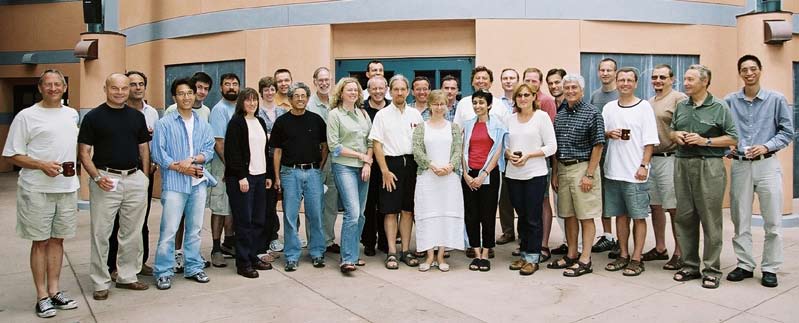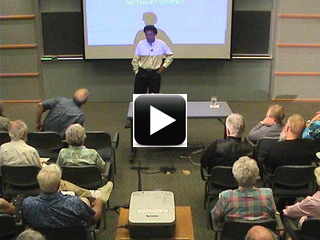 Participants in “Cardiac Dynamics” mini-program. Photo by Nell Campbell.
Participants in “Cardiac Dynamics” mini-program. Photo by Nell Campbell.
"Cardiac Dynamics," a month-long, KITP mini-program held in the summer of 2006, brought together physicists, cardiologists, and biomedical scientists and engineers for interdisciplinary collaboration on the application of techniques of non-linear dynamics to understanding the sub-set of cardiac arrhythmias that are potentially fatal.
When the lower, bigger chambers of the human heart — the ventricles — quiver or fibrillate, death almost always ensues unless a defibrillator is applied to halt the fatal process. Ventricular fibrillation generally follows a regime of rapid rhythm or ventricular “tachycardia” (not to be confused with the heart “flutter” people typically sense as an arrhythmia, which pertains to the upper, smaller chambers or atria).
In the United States, more than half the sudden deaths due to cardiac disease follow directly from ventricular tachycardia and fibrillation. The only efficient method currently available to prevent cardiac death is to deliver a huge electrical shock to the fibrillating heart, wiping out the vortices that cause fibrillation. However, these shocks may irreversibly damage heart tissue.
“Developing a fundamental understanding of the mechanisms that trigger and maintain life-threatening cardiac arrhythmias is crucially important for designing anti-arrhythmic therapies that successfully reduce mortality,” according to the proposal submitted by mini-program organizers.
Ventricular tachycardia and fibrillation represent extremely complicated, non-linear patterns in both space and time that are “multi-scale” problems, encompassing a range of dynamics from the operation of ion channels in a single cell to the wave movement of ion channel operation in tissue (from cell to cell) to the beating of the heart itself over a lifetime.
The physics approach to the problem of cardiac dynamics is through the study of excitable media that can form spiral waves.
One important aspect of cardiac dynamics is akin to the behavior of a forest fire that burns vegetation in a moving, wavelike pattern. The forest cannot re-burn — another wave of fire cannot propagate — until the forest has re-grown. That necessary period of recovery when a wave cannot be propagated is characteristic of non-linear excitable media. Anomalous spacial variation in such regions can initiate wave patterns leading to fatal cardiac arrhythmias.
The month-long program in 2006 followed from a four-month KITP program on “Pattern Formation in Physics and Biology” in the fall of 2003 that devoted one week to cardiac dynamics. Written feedback on that experience showed that the cardiologists especially appreciated and were stimulated by the questions the physicists raised, according to “Pattern Formation” program organizer and physicist Eberhard Bodenschatz of the Max Planck Institute of Biophysical Chemistry in Göttingen, Germany.
Bodenschatz also served as an organizer of the 2006 “Cardiac Dynamics” mini-program. Its other organizers included biomedical engineer Emilia Entcheva, State University of New York, Syracuse; physiologist Robert Gilmour, College of Veterinary Medicine, Cornell University, Ithaca; physicist Alain Karma, Northeastern University, Boston; and physicist Valentin Krinsky, CNRS Institute for Non-Linearity, Nice, France.
In conjunction with the mini-program, Karma, gave a public lecture for the Friends of KITP and the community. That lecture is available to view below and at http://online.kitp.ucsb.edu/online/plecture/karma/.
Karma and Gilmour also co-authored an article, “Nonlinear Dynamics of Heart Rhythm Disorders,” which appeared in the March 2007 issue of Physics Today. The authors note, “This article grew out of an interdisciplinary workshop on cardiac dynamics hosted in July 2006 by the Kavli Institute for Theoretical Physics in Santa Barbara, California, and supported by NSF, the Burroughs Wellcome Fund, and DARPA.”
 |
